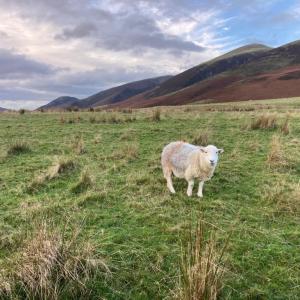
Lameness on UK sheep farms is a huge welfare issue and needs to be kept to a minimum in order for farmers to maintain their productivity and profitability. In Great Britain, footrot alone is estimated to cost the sheep industry between £20-80 million every year. A target for any sheep farm is a lameness prevalence of less than 2%. For flocks with a lameness prevalence of 10% or more, footrot losses equate to £6.35 per ewe. It is nearly impossible to eradicate lameness from a flock, but it is important to correctly identify the cause and treat appropriately.

There are 6 main causes of lameness in sheep.
Scald is the early presentation of footrot caused by the bacteria dichelobacter nodosus. Infection occurs due to skin damage from rough pastures, thorns, thistles or prolonged exposure to moisture, which softens the skin barrier.
Footrot is a progression from Scald with the bacteria (as above) nearly endemic on UK sheep farms as it lives on pasture where it can survive for 14 days. Infection spreads in wet, soiled areas such as gateways and around handling facilities. The bacteria can also spread indoors where there is a high stocking density, often at lambing time.
CODD (contagious ovine digital dermatitis) is an infection caused by bacteria and often results in severe lameness. It is usually seen at the top of the hoof (coronary band), which can be an important way of distinguishing CODD from footrot.
A toe granuloma is more likely to occur on farms where footrot and CODD are also present. It is an area of flesh under the sole horn that grows to a red pea sized ball. The tissue can be extremely sensitive and bleeds easily. Caused by foot damage, it is usually linked to excessive trimming and footbathing.
A toe abscess is caused by a puncture of the hoof or separation of the white line, leading to infection and the oozing of pus, often from the coronary band.
Shelly hoof leads to lameness. The cause is unknown, but hoof damage from rough, wet ground or sheep walking excessively on stones has been indicated. The hoof wall and toe horn separate, making secondary infections more likely.
Preventing lameness is much better than treating it. The 5-point (management) plan is recommended where footrot, scald and/or CODD has been identified;
1. Cull
Infection can spread very quickly through a flock so identifying and culling repeat offenders is paramount
2. Quarantine
Isolating affected animals for four weeks can help to reduce transmission of disease. It is important to quarantine any purchased sheep, but maintaining a closed flock is also beneficial.
3. Treat
Treating all lame sheep quickly. The most appropriate treatment depends on the cause.
4. Avoid
It is very important to avoid spreading infection when sheep are housed, or going through handling facilities. Increase resilience in your flock by not breeding or buying replacements that have previously suffered from scald or footrot. If possible avoid buying in.
5. Vaccinate
There is an effective licensed vaccine available to help prevent footrot.
We advise that all farms have a robust control strategy tailored to an individual farm to prevent and treat lameness. Farmers have an extremely important role to play in UK food production. Ensuring animals are healthy and free from disease gives the consumer confidence, knowing that the produce they buy is of the highest quality and produced with the highest levels of welfare. To implement a lameness control strategy or for more information on preventing lameness in your flock, speak to your vet.